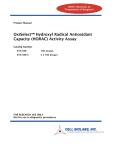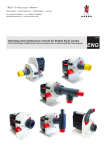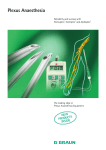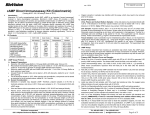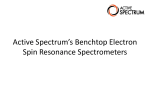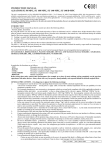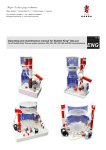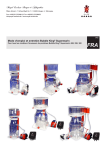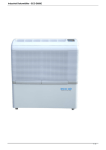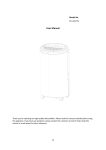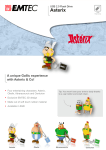Download (HORAC) Activity Assay, Trial Size
Transcript
Product Manual OxiSelect™ Hydroxyl Radical Antioxidant Capacity (HORAC) Activity Assay, Trial Size Catalog Number STA-346-T 48 assays FOR RESEARCH USE ONLY Not for use in diagnostic procedures Introduction Oxidative stress is a physiological condition where there is an imbalance between concentrations of reactive oxygen species (ROS) and antioxidants. However, excessive ROS accumulation will lead to cellular injury, such as damage to DNA, proteins, and lipid membranes. The cellular damage caused by ROS has been implicated in the development of many disease states, such as cancer, diabetes, cardiovascular disease, atherosclerosis, and neurodegenerative diseases. Under normal physiological conditions, cellular ROS generation is counterbalanced by the action of cellular antioxidant enzymes and other redox molecules. Because of their potential harmful effects, excessive ROS must be promptly eliminated from the cells by this variety of antioxidant defense mechanisms. Antioxidants include both hydrophilic and lipophilic molecules for metabolizing ROS. Although the products of ROS-induced oxidative stress are extensively used to monitor the effects of oxidative stress, it is also important to evaluate the antioxidant capacity of biological fluids, cells, and extracts. The Hydroxyl Radical Antioxidant Capacity (HORAC) Assay is a classic tool for measuring the antioxidant capacity of biomolecules from a variety of samples. The HORAC Activity Assay is based on the oxidation of a fluorescent probe by hydroxyl radicals by way of a hydrogen atom transfer (HAT) process. Hydroxyl radicals are produced by hydroxyl radical initiator and fenton reagent, which quenches the fluorescent probe over time. Antioxidants present in the assay work to block the radical hydroxyl oxidation of the fluorescent probe until the antioxidant activity in the sample is depleted. The remaining hydroxyl radicals destroy the fluorescence of the fluorescent probe. This assay continues until completion, which means both the antioxidant’s inhibition time and inhibition percentage of free radical damage is a single value. The sample antioxidant capacity correlates to the fluorescence decay curve, which is usually represented as the area under the curve (AUC). The AUC is used to quantify the total hydroxyl radical antioxidant activity in a sample and is compared to a gallic acid antioxidant standard curve. Cell Biolabs’ OxiSelect™ HORAC Activity Assay is a fast and reliable kit for the direct measurement of HORAC antioxidant capacity from cell lysate, plasma, serum, tissue homogenates, and food extracts. This Trial Size kit provides sufficient reagents to perform up to 48 assays, including blanks, antioxidant standards and unknown samples. The assay is designed for use in single plate microplate readers as well as readers with high-throughput capabilities. Please read the complete kit insert prior to performing the assay. 2 Assay Principle Related Products 1. STA-305: OxiSelect™ Nitrotyrosine Protein ELISA Kit 2. STA-310: OxiSelect™ Protein Carbonyl ELISA Kit 3. STA-312: OxiSelect™ Total Glutathione (GSSG/GSH) Assay Kit 4. STA-320: OxiSelect™ Oxidative DNA Damage ELISA Kit (8-OHdG Quantitation) 5. STA-324: OxiSelect™ Oxidative DNA Damage Quantitation Kit (AP Sites) 6. STA-330: OxiSelect™ TBARS Assay Kit (MDA Quantitation) 7. STA-337: OxiSelect™ 8-iso-Prostaglandin F2α ELISA Kit (96 Assays) 8. STA-340: OxiSelect™ Superoxide Dismutase Activity Assay 9. STA-341: OxiSelect™ Catalase Activity Assay 10. STA-345: OxiSelect™ ORAC Activity Assay Kit Components 1. 96-well Microtiter Plate (Part No. 234501): One 96-well clear bottom black plate. 2. HORAC Fluorescein Probe (100X) (Part No. 234601-T): One 75 µL tube. 3. Hydroxyl Radical Initiator (5X) (Part No. 234602-T): One 200 µL amber tube. 4. Gallic Acid Antioxidant Standard (Part No. 234603): One 1.5 mL tube of a 5 mM solution. 5. Fenton Reagent (Part No. 234604-T): One 1 mL tube. 6. Assay Diluent (2X) (Part No. 234605-T): One 10 mL bottle. 3 Materials Not Supplied 1. Sample extracts for testing 2. Deionized water 3. 37ºC incubator 4. 5. 6. 7. 8. 9. Bottles, flasks, and conical or microtubes necessary for reagent preparation Reagents and materials necessary for sample extraction and purification 10 µL to 1000 µL adjustable single channel micropipettes with disposable tips 50 µL to 300 µL adjustable multichannel micropipette with disposable tips Multichannel micropipette reservoir Fluorescence microplate reader equipped with a 485 nm excitation filter and 530 nm emission filter Storage Upon receiving, store the HORAC Fluorescein Probe (100X) and Antioxidant Standard at -20ºC and the Fenton Reagent, Hydroxyl Radical Initiator and Assay Diluent at 4ºC. Aliquot as necessary to avoid multiple freeze/thaw cycles. Store all remaining kit components at room temperature until their expiration dates. Preparation of Reagents Assay Diluent (2X): Dilute the Assay Diluent 1:2 with deionized water. Mix to homogeneity. Use this for all sample and standard dilutions. Store the 1X Assay Diluent at 4ºC. Fluorescein Probe (100X): Dilute the Fluorescein Probe 1:100 with Assay Diluent. Mix to homogeneity. Label this as 1X Fluorescein Solution. Use only enough Fluorescein Probe as necessary for immediate applications. Hydroxyl Radical Initiator (5X): Dilute the Hydroxyl Radical Initiator 1:5 with deionized or distilled water. Mix to homogeneity. Label this solution as 1X Hydroxyl Radical Initiator Solution. Use only enough Hydroxyl Radical Initiator as necessary for immediate use. Note: Do not store diluted Fluorescein Probe or Hydroxyl Radical Initiator solutions. Preparation of Samples Note: Samples should be stored at -70ºC prior to performing the assay. Sample should be prepared at the discretion of the user. The following recommendations are only guidelines and may be altered to optimize or complement the user’s experimental design. Deproteinated Fractions: Samples can be deproteinated and have their non-protein fractions assayed. Mix samples with 0.5 M perchloric acid (1:2, v/v), centrifuge at 10,000 x g for 10 minutes at 4ºC. Remove the supernatant for measuring the non-protein fraction in the assay. Cell Culture: Wash cells 3 times with cold PBS prior to lysis. Lyse cells with sonication or homogenation in cold PBS and centrifuge at 10,000 x g for 10 minutes at 4ºC. Aliquot and store the supernatant for use in the assay. 4 Lipophilic Fractions: Lipophilic samples must be treated in order to be soluble in an aqueous environment. Dissolve samples in 100% acetone and then dilute in a solution of 7% betacyclodextrin and 50% acetone. Incubate the mixture for 1 hour at room temperature with mixing. Further dilute samples as necessary prior to testing. Plasma: Collect blood with heparin and centrifuge at 4ºC for 10 minutes. Remove the plasma and aliquot samples for testing. Blood plasma or serum should be diluted 100-fold or more with Assay Diluent prior to performing the assay. Tissue Lysate: Sonicate or homogenize tissue sample on cold PBS and centrifuge at 10,000 x g for 10 minutes at 4ºC. Aliquot and store the supernatant for use in the assay. Plasma or Serum: Once samples are collected they may be tested after diluted 100 fold with Assay Diluent. Urine: Once samples are collected they may be tested directly or diluted with Assay Diluent if appropriate. Nutrition Samples: Nutritional sample results may vary depending on sample source and purification. Dilution and preparation of these samples is at the discretion of the user. Aqueous samples, such as juice extracts, may be tested directly without further manipulation. Solid food samples or high protein samples may be processed as follows: o Solid Samples: Weigh solid sample and then homogenize after adding deionized water (1:2, w/v). Centrifuge the homogenate at 10-12,000 x g for 10 minutes at 4ºC. Recover the supernatant which is the water-soluble fraction. The solid pulp, or insoluble fraction is also recovered and washed with deionized water. Combine this wash with the supernatant. The pooled supernatant can be diluted with Assay Diluent and used directly in the assay. The pulp is further extracted by adding pure acetone (1:4, w(solid pulp)/v) and mixing at room temperature for 30-60 minutes. Centrifuge the extract/solid at 12,000 x g for 10 minutes at 4ºC. Recover the acetone extract and dilute with Assay Diluent as necessary prior to running the assay. The total ORAC value is calculated by combining the results from the water-soluble fraction and the acetone extract from the pulp fraction. o Aqueous Samples: Centrifuge the sample at 5-10,000 x g for 10 minutes at 4ºC to remove any particulates. Dilute the supernatant as necessary prior to running the assay. 5 Preparation of Antioxidant Standard Curve 1. Prepare fresh standards by diluting the 5 mM Gallic Acid Antioxidant Standard stock solution in 1X Assay Diluent. Use only enough Gallic Acid Antioxidant Standard as necessary for immediate applications. 2. Prepare a series of the remaining antioxidant standards according to Table 1 below. Tubes 1 2 3 4 5 6 7 8 9 10 Gallic Acid Antioxidant Standard (µL) 90 80 70 60 50 40 30 20 10 0 Assay Diluent (µL) 410 420 430 440 450 460 470 480 490 500 Gallic Acid Concentration (µM) 900 800 700 600 500 400 300 200 100 0 Table 1. Preparation of Gallic Acid Antioxidant Standards Note: Do not store diluted Antioxidant Standard solutions. Prepare fresh Antioxidant Standards for every assay performed. Assay Protocol Note: Each Antioxidant Standard and samples should be assayed in duplicate or triplicate. A freshly prepared standard curve should be used each time the assay is performed. 1. Add 20 µL of the diluted Antioxidant Standards or samples to be tested to the 96-well Microtiter Plate. 2. Add 140 µL of the 1X Fluorescein Solution to each well. Mix thoroughly. Incubate the plate for 30 minutes at room temperature. 3. Add 20 µL of the 1X Hydroxyl Radical Initiator into each well using either a multichannel pipette or a plate reader liquid handling system. 4. Immediately add 20 µL of the Fenton Reagent to each well. Shake the plate immediately for 15 seconds to ensure homogeneity. 5. Immediately begin reading sample and standard wells with a fluorescent microplate reader with an excitation wavelength of 480nm and an emission wavelength of 530nm. Read the wells in increments between 1 and 5 minutes for a total of 60 minutes. Save values for Calculation of Results below. Note: The final assay values of blank control should be less than 10% of the initial values in order for the assay to be completed. 6 Example of Results The following figure demonstrates typical OxiSelect™ HORAC Activity Assay results. One should use the data below for reference only. This data should not be used to interpret or calculate actual sample results. 9 1400 8 1200 7 1000 6 RFU Net AUC 800 µM Gallic Acid Blank 800 600 5 4 3 400 2 200 1 0 0 0 10 20 30 40 50 60 0 70 200 400 600 800 1000 Gallic Acid (µM ) Time (Min) Figure 1: HORAC Activity Assay Standard Curve. Calculation of Results Note: A spreadsheet application or plate reader software can be used to perform the calculations. 1. Calculate the area under the curve (AUC) for each sample and standard using the final assay values and the linear regression formula below. The AUC can be calculated from the equation below: AUC = 1 + RFU1/RFU0 + RFU2/RFU0 + RFU3/RFU0 +……+ RFU59/RFU0 + RFU60/RFU0 RFU0 = relative fluorescence value of time point zero. RFUx = relative fluorescence value of time points (eg. RFU5 is relative fluorescence value at minute five) AUC (Antioxidant) AUC (Blank) 1.2 1 1 0.8 0.8 RFU RFU 1.2 0.6 0.6 0.4 0.4 0.2 0.2 0 0 0 5 10 15 20 25 30 35 40 45 50 55 60 0 Time (min) 5 10 15 20 25 30 35 40 45 Time (min) 7 50 55 60 2. Calculate the Net AUC by subtracting the Blank AUC from the AUC of each sample and standard. Net AUC = AUC (Antioxidant) – AUC (blank) Net AUC 1.20 1.00 RFU 0.80 0.60 0.40 0.20 0.00 5 10 15 20 25 30 35 40 45 50 55 60 Time (min) 3. Graph the Net AUC on the y-axis against the Gallic Acid Antioxidant Standard concentration on the x-axis (see Figure 1) 4. Calculate the µMole Gallic Acid Equivalents (GAE) of unknown sample by comparing the standard curve. Results (HORAC value) may be expressed as GAE per L or g of sample. Calculation Example: 20 µL of 10-fold diluted sample is assayed along with 20 µL of each Gallic Acid antioxidant standard including blank as described in Assay Protocol. The average AUC is 2.2 for blank and 7.0 for sample. Net AUC = AUC (Antioxidant) – AUC (blank) = 7.0 – 2.2 = 4.8 Based on the Gallic Acid antioxidant standard curve, the equivalent Gallic Acid concentration is 400 µM, therefore, HORAC value (Sample) = 400 µM x 10 (dilution factor) = 4000 µM GAE = 4000 µMole GAE/L References 1. Huang, D., Ou, B., & Prior, R. (2005) J. Agric. Food Chem. 53: 1841-1856. 2. Ou, B., Hampsch-Woodill, M., and Prior, R. (2001) J. Agric. Food Chem. 49: 4619-4626. 3. Ou, B., Hampsch-Woodill, M., Flanagan J., Deemer E., Prior, R. and Huang D. (2002) J. Agric. Food Chem. 50: 2772-2777. 8 Recent Product Citations 1. Gardner, A. W. et al. (2015). Endothelial cell inflammation and antioxidant capacity are associated with exercise performance and microcirculation in patients with symptomatic peripheral artery disease. Angiology. doi:10.1177/0003319714566863. 2. Jeong, M. H. et al. (2014). In vitro evaluation of Cordyceps militaris as a potential radioprotective agent. Int J Mol Med. 34:1349-1357. 3. Mishra, S. et al. (2014). Semiquinone glucoside derivative (SQGD) isolated from Bacillus sp. INM1 protects against gamma radiation-induced oxidative stress. Environ Toxicol Pharmacol. 37:553562. 4. Gardner, A. W. et al. (2014). Gender and racial differences in endothelial oxidative stress and inflammation in patients with symptomatic peripheral artery disease. J Vasc Surg. 61:1249-1257. 5. Gardner, A. W. et al. (2014). Greater endothelial apoptosis and oxidative stress in patients with peripheral artery disease. Int J Vasc Med. doi:10.1155/2014/160534. 6. Gardner, A. W. et al. (2014). Impaired vascular endothelial growth factor A and inflammation in patients with peripheral artery disease. Angiology. 65:683-690. 7. Jeong, M.H. et al. (2014). Protective activity of a novel resveratrol analogue, HS-1793, against DNA damage in 137Cs-irradiated CHO-K1 cells. J Radiat Res. 55:464-475. 8. Bailey-Downs. et al. (2013). Aging exacerbates obesity-induced oxidative stress and inflammation in perivascular adipose tissue in mice: a paracrine mechanism contributing to vascular redox dysregulation and inflammation. J Gerontol A Biol Sci Med Sci. 68:780-792. 9. Ungvari, Z. et al. (2013). Testing Predictions of the oxidative stress hypothesis of aging using a novel invertebrate model of longevity: the giant clam (Tridacna derasa). J Gerontol A Biol Sci Med Sci. 68:359-367 10. Downs, L.C. et al. (2012). Aging exacerbates obesity-induced oxidative stress and inflammation in perivascular adipose tissue in mice: a paracrine mechanism contributing to vascular redox dysregulation and inflammation. J Gerontol A Biol Sci Med Sci. 10.1093/gerona/ gls238. 11. Bailey-Downs, L.C. et al. (2011). Liver-specific knockdown of IGF-1 decreases vascular oxidative stress resistance by impairing the Nrf2-dependent antioxidant response: a novel model of vascular aging. J. Gerontol A Biol Sci Med Sci. 67A:313-329. 12. Ungvari, Z. et al. (2011). Extreme longevity is associated with increased resistance to oxidative stress in Arctica islandica, the longest-living non-colonial animal. J. Gerontol A Biol Sci Med Sci. 10.1093/gerona/glr044 13. Ungvari, Z. et al. (2011). Free radical production, antioxidant capacity, and oxidative stress response signatures in fibroblasts from lewis dwarf rats: effects of life span-extending peripubertal GH treatment. J. Gerontol. A Biol Sci Med Sci. 10.1093/gerona/glr004. Warranty These products are warranted to perform as described in their labeling and in Cell Biolabs literature when used in accordance with their instructions. THERE ARE NO WARRANTIES THAT EXTEND BEYOND THIS EXPRESSED WARRANTY AND CELL BIOLABS DISCLAIMS ANY IMPLIED WARRANTY OF MERCHANTABILITY OR WARRANTY OF FITNESS FOR PARTICULAR PURPOSE. CELL BIOLABS’s sole obligation and purchaser’s exclusive remedy for breach of this warranty shall be, at the option of CELL BIOLABS, to repair or replace the products. In no event shall CELL BIOLABS be liable for any proximate, incidental or consequential damages in connection with the products. 9 Contact Information Cell Biolabs, Inc. 7758 Arjons Drive San Diego, CA 92126 Worldwide: +1 858 271-6500 USA Toll-Free: 1-888-CBL-0505 E-mail: [email protected] www.cellbiolabs.com 2014-2015: Cell Biolabs, Inc. - All rights reserved. No part of these works may be reproduced in any form without permissions in writing. 10










